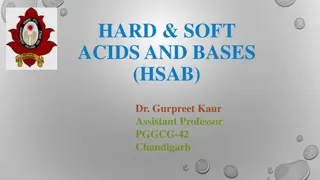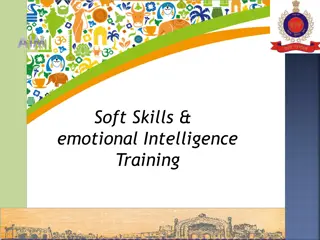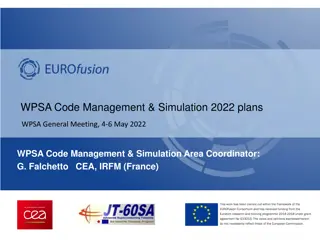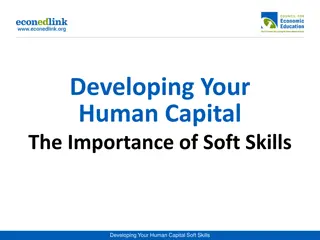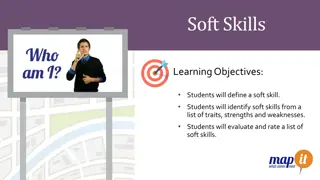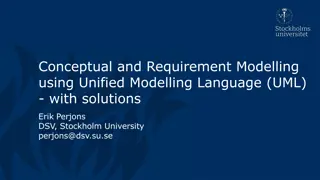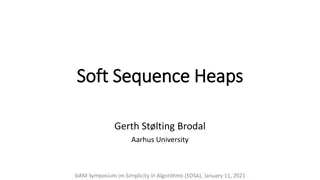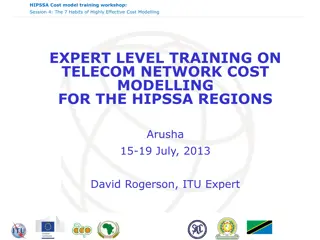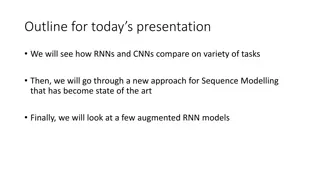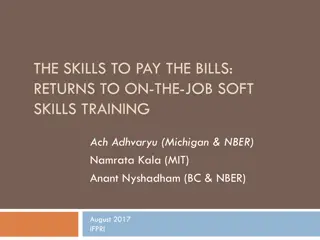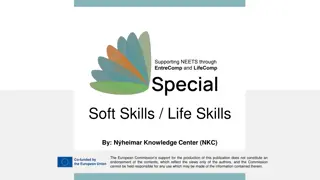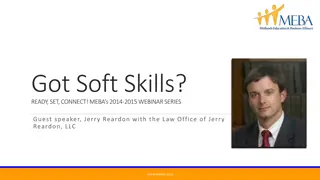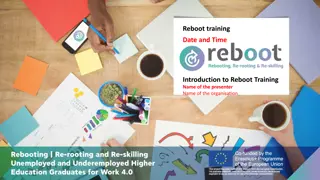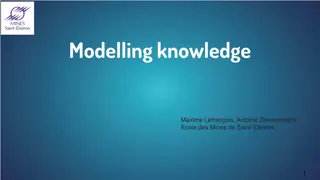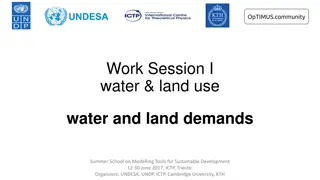Soft Systems Modelling Overview and Methods of Analysis
Soft Systems Modelling provides a structured approach to analyzing complex systems by employing methods such as CATWOE, Critical Systems Heuristics, and Stakeholder Personas. Root Definitions are utilized to gather evidence for system assessment, focusing on the core activities. The CATWOE technique identifies key elements in a system, including Customers, Actors, Transformation, World View, Owners, and Environment. An example scenario involving an air traffic control system illustrates the application of CATWOE in practice.
Download Presentation

Please find below an Image/Link to download the presentation.
The content on the website is provided AS IS for your information and personal use only. It may not be sold, licensed, or shared on other websites without obtaining consent from the author.If you encounter any issues during the download, it is possible that the publisher has removed the file from their server.
You are allowed to download the files provided on this website for personal or commercial use, subject to the condition that they are used lawfully. All files are the property of their respective owners.
The content on the website is provided AS IS for your information and personal use only. It may not be sold, licensed, or shared on other websites without obtaining consent from the author.
E N D
Presentation Transcript
Soft Systems Modelling 1 David Millard dem@soton.ac.uk | @hoosfoos | davidmillard.org
Overview Reminder: Soft Systems 7 stage method Methods of Analysis CATWOE Critical Systems Heuristics Expressing the Model Systems Diagram Stakeholder Personas
Soft Systems Method: 7 Stage Method Real world Actions for change Work with users Get information Draw pictures Debate with actors People at the heart of the process Compare models with problem situation Analyse problem situation Conceptual world Construct conceptual model Formulate root definitions But how do we do these things?
Root Definition? Used when gathering evidence for a system Called a root definition because it describes the root or core of the activity to be modelled Explores the problem situation as a basis for change Brings users into the heart of the system Has been observed that the most successful root definitions include the people, processes and environment (described by the mnemonic CATWOE)
CATWOE a system Customers/clients Actors Transformation World view Owners Environment owned by Owner populated by Actors with different World Views driving a Transformation (given the constraints of some Environment) for a particular Customer
Example: Consider the air traffic control system for landing planes at an airport CATWOE Customers Actors Transformation World View In example Passengers Pilots, Air Traffic Controllers Planes land based on instructions Commercial considerations of airport operators, local residents may have concerns over noise pollution, safety requirements Airport operators and Airlines Airport topography and geography, weather, commercial competition Owners Environment
Example: Consider the air traffic control system for landing planes at an airport CATWOE Customers Actors Transformation World View In example Passengers Pilots, Air Traffic Controllers Planes land based on instructions Commercial considerations of airport operators, local residents may have concerns over noise pollution, safety requirements Airport operators and Airlines Airport topography and geography, weather, commercial competition Owners Environment
Definition: a heuristic is A heuristic is a replicable method or approach for directing one's attention in learning, discovery, or problem-solving. It is derived from the Greek "heurisko" ( ), which means "I find". (A form of the same verb is found in Archimedes' famous exclamation "eureka!" "I have found [it]!") The term was introduced in the 4th century AD by Pappus of Alexandria. wikipedia
Critical Systems Heuristics: another soft systems approach for discovery The basic idea of CSH is to support a systematic handling of boundary judgments critically. Boundary judgments determine which empirical observations and value considerations count as relevant and which others are left out or are considered less important. Definition: Werner Ulrich
Critical Systems Heuristics: another soft systems approach for discovery A framework for asking questions The basic idea of CSH is to support a systematic handling of boundary judgments critically. Boundary judgments determine which empirical observations and value considerations count as relevant and which others are left out or are considered less important. To identify boundary judgments systematically Boundary judgements are selective They are intended to leave things out to fit the purpose of the model. So they are partial Different boundary judgments create a different model Heuristics help us to explore soft (ill-defined, qualitative) issues such as values and assumptions Definition: Werner Ulrich
Sources of influence Social roles (Stakeholders) Specific concerns (Stakes) Key problems (Stakeholding issues) Basis of motivation Where does a sense of purposefulness and value come from? Sources of motivation 1. Beneficiary Who ought to be/ is the intended beneficiary of the system (S)? Who benefits? 2. Purpose What ought to be/is the purpose of S? 3. Measure of improvement What ought to be/is S s measure of success Sources of control 4. Decision maker Who ought to be/is in control of the conditions of success of S? 5. Resources What conditions of success ought to be/are under the control of S? 6. Decision environment What conditions of success ought to be/are outside the control of the decision maker? Basis of power Who is in control of what is going on and is needed for success? Basis of knowledge What experience and expertise support the claim? Sources of knowledge 7. Expert Who ought to be/is providing relevant knowledge and skills for S? 8. Expertise What ought to be/are relevant new knowledge and skills for S? 9. Guarantor What ought to be/are regarded as assurances of successful implementation? Sources of legitimacy 10. Witness Who ought to be/ is representing the interests of those negatively affected by but not involved with S? 11. Emancipation What ought to be/are the opportunities for the interests of those negatively affected to have expression and freedom from the worldview of S? 12. Worldview What space ought to be/ is available for reconciling differing worldviews regarding S among those involved and affected? Basis of legitimacy Where does legitimacy lie? Ulrich, Werner and Reynolds, Martin (2010). Critical systems heuristics. In: Reynolds, Martin and Holwell, Sue eds. Systems Approaches to Managing Change: A Practical Guide. London: Springer, pp. 243 292
Sources of influence Social roles (Stakeholders) Specific concerns (Stakes) Key problems (Stakeholding issues) Sources of motivation 1. Beneficiary Who ought to be/ is the intended beneficiary of the system (S)? 2. Purpose What ought to be/is the purpose of S? 3. Measure of improvement What ought to be/is S s measure of success Sources of control 4. Decision maker Who ought to be/is in control of the conditions of success of S? 5. Resources What conditions of success ought to be/are under the control of S? 6. Decision environment What conditions of success ought to be/are outside the control of the decision maker? Basis of power Who is in control of what is going on and is needed for success? Basis of knowledge What experience and expertise support the claim? Sources of knowledge 7. Expert Who ought to be/is providing relevant knowledge and skills for S? 8. Expertise What ought to be/are relevant new knowledge and skills for S? 9. Guarantor What ought to be/are regarded as assurances of successful implementation? Sources of legitimacy 10. Witness Who ought to be/ is representing the interests of those negatively affected by but not involved with S? 11. Emancipation What ought to be/are the opportunities for the interests of those negatively affected to have expression and freedom from the worldview of S? 12. Worldview What space ought to be/ is available for reconciling differing worldviews regarding S among those involved and affected? Basis of legitimacy Where does legitimacy lie? Ulrich, Werner and Reynolds, Martin (2010). Critical systems heuristics. In: Reynolds, Martin and Holwell, Sue eds. Systems Approaches to Managing Change: A Practical Guide. London: Springer, pp. 243 292
Sources of influence Social roles (Stakeholders) Specific concerns (Stakes) Key problems (Stakeholding issues) Sources of motivation 1. Beneficiary Who ought to be/ is the intended beneficiary of the system (S)? 2. Purpose What ought to be/is the purpose of S? 3. Measure of improvement What ought to be/is S s measure of success Sources of control 4. Decision maker Who ought to be/is in control of the conditions of success of S? 5. Resources What conditions of success ought to be/are under the control of S? 6. Decision environment What conditions of success ought to be/are outside the control of the decision maker? Basis of knowledge What experience and expertise support the claim? Sources of knowledge 7. Expert Who ought to be/is providing relevant knowledge and skills for S? 8. Expertise What ought to be/are relevant new knowledge and skills for S? 9. Guarantor What ought to be/are regarded as assurances of successful implementation? Sources of legitimacy 10. Witness Who ought to be/ is representing the interests of those negatively affected by but not involved with S? 11. Emancipation What ought to be/are the opportunities for the interests of those negatively affected to have expression and freedom from the worldview of S? 12. Worldview What space ought to be/ is available for reconciling differing worldviews regarding S among those involved and affected? Basis of legitimacy Where does legitimacy lie? Ulrich, Werner and Reynolds, Martin (2010). Critical systems heuristics. In: Reynolds, Martin and Holwell, Sue eds. Systems Approaches to Managing Change: A Practical Guide. London: Springer, pp. 243 292
Sources of influence Social roles (Stakeholders) Specific concerns (Stakes) Key problems (Stakeholding issues) Sources of motivation 1. Beneficiary Who ought to be/ is the intended beneficiary of the system (S)? 2. Purpose What ought to be/is the purpose of S? 3. Measure of improvement What ought to be/is S s measure of success Sources of control 4. Decision maker Who ought to be/is in control of the conditions of success of S? 5. Resources What conditions of success ought to be/are under the control of S? 6. Decision environment What conditions of success ought to be/are outside the control of the decision maker? Sources of knowledge 7. Expert Who ought to be/is providing relevant knowledge and skills for S? 8. Expertise What ought to be/are relevant new knowledge and skills for S? 9. Guarantor What ought to be/are regarded as assurances of successful implementation? Sources of legitimacy 10. Witness Who ought to be/ is representing the interests of those negatively affected by but not involved with S? 11. Emancipation What ought to be/are the opportunities for the interests of those negatively affected to have expression and freedom from the worldview of S? 12. Worldview What space ought to be/ is available for reconciling differing worldviews regarding S among those involved and affected? Basis of legitimacy Where does legitimacy lie? Ulrich, Werner and Reynolds, Martin (2010). Critical systems heuristics. In: Reynolds, Martin and Holwell, Sue eds. Systems Approaches to Managing Change: A Practical Guide. London: Springer, pp. 243 292
Sources of influence Social roles (Stakeholders) Specific concerns (Stakes) Key problems (Stakeholding issues) Sources of motivation 1. Beneficiary Who ought to be/ is the intended beneficiary of the system (S)? 2. Purpose What ought to be/is the purpose of S? 3. Measure of improvement What ought to be/is S s measure of success Sources of control 4. Decision maker Who ought to be/is in control of the conditions of success of S? 5. Resources What conditions of success ought to be/are under the control of S? 6. Decision environment What conditions of success ought to be/are outside the control of the decision maker? Sources of knowledge 7. Expert Who ought to be/is providing relevant knowledge and skills for S? 8. Expertise What ought to be/are relevant new knowledge and skills for S? 9. Guarantor What ought to be/are regarded as assurances of successful implementation? Sources of legitimacy 10. Witness Who ought to be/ is representing the interests of those negatively affected by but not involved with S? 11. Emancipation What ought to be/are the opportunities for the interests of those negatively affected to have expression and freedom from the worldview of S? 12. Worldview What space ought to be/ is available for reconciling differing worldviews regarding S among those involved and affected? Ulrich, Werner and Reynolds, Martin (2010). Critical systems heuristics. In: Reynolds, Martin and Holwell, Sue eds. Systems Approaches to Managing Change: A Practical Guide. London: Springer, pp. 243 292
Sources of influence Social roles (Stakeholders) Specific concerns (Stakes) Key problems (Stakeholding issues) Sources of motivation 1. Beneficiary Who ought to be/ is the intended beneficiary of the system (S)? 2. Purpose What ought to be/is the purpose of S? 3. Measure of improvement What ought to be/is S s measure of success Sources of control 4. Decision maker Who ought to be/is in control of the conditions of success of S? 5. Resources What conditions of success ought to be/are under the control of S? 6. Decision environment What conditions of success ought to be/are outside the control of the decision maker? Sources of knowledge 7. Expert Who ought to be/is providing relevant knowledge and skills for S? 8. Expertise What ought to be/are relevant new knowledge and skills for S? 9. Guarantor What ought to be/are regarded as assurances of successful implementation? Sources of legitimacy 10. Witness Who ought to be/ is representing the interests of those negatively affected by but not involved with S? 11. Emancipation What ought to be/are the opportunities for the interests of those negatively affected to have expression and freedom from the worldview of S? 12. Worldview What space ought to be/ is available for reconciling differing worldviews regarding S among those involved and affected? Ulrich, Werner and Reynolds, Martin (2010). Critical systems heuristics. In: Reynolds, Martin and Holwell, Sue eds. Systems Approaches to Managing Change: A Practical Guide. London: Springer, pp. 243 292
Soft Systems Diagram Is a diagram of the reference system which can provide a narrative for the evidence that is collected Shows where evidence and information is missing or unsupported Encourages critical questioning of: Legitimacy, Ownership, Assumptions, Motivations Captures your understanding of the problem Communicates your understanding of the problem If we can t explain and qualify the reference system, we probably don t know enough to solve the problem
Systems Diagram System Name alliances System owner Manager/Supervisor conflicts resource Standards authority measurements Corrective action Beliefs Values Attitudes Motivation processes Actors Outputs B A D C Emergent properties Beneficiaries & victims Inputs
Systems diagram components Soft: Interpersonal, political organisational, Alliances Beliefs Hard: Technical System boundary Inputs Managers/sup ervisors Beneficiaries/ victims standards conflicts perceptions Control sub system Authority values actors outputs measurements resources Motivations System owners processes Corrective actions attitudes Emergent properties
How do we build the Soft Systems Diagram? Boundary Judgments what is in and what is to be left out Critical Questioning of Basis of motivation Where does a sense of purposefulness and value come from? Who benefits? Basis of power Who is in control of what is going on and is needed for success? Basis of knowledge What experience and expertise support the claim? Basis of legitimacy Where does legitimacy lie? CATWOE what is the system? Customers, Actors, Transformations, World Views, Owners and Environement What relationships and values cause behaviour in the system Identify where evidence and information is missing or unsupported
Users (Stakeholders) Stakeholders - astakeholder is anyone that is involved in or affected by the activity in a domain or system. Actor Beneficiary Victim Customer Owner We need to gather evidence about the characteristics and concerns associated with each stakeholder We need to gather evidence about difficulties arising from those concerns (can t be met or competing)
Stakeholder Personas Using Personas is a technique that allows us to examine values and motivations that cause behaviour Personas are representatives describing stakeholders in some detail describing their background, job function, situation in the organisation, Beliefs, anxieties and so on, often including a representative image. Personas can describe variants of a particular role, for instance, the ideal student, the laid back student, the anxious student.
Example Persona Louise is a new graduate working for the airport, she is enthusiastic about how new technology might improve the running of the airport, but concerned that her views might not be taken seriously by more senior colleagues. New Graduate working in the Airport s business development unit
Why Use Personas? Using personas adds a motivational aspect to the stakeholders, and can be a useful method of reflecting on what they actually want from the system. Personas are not real people! The characteristics of the personas should be backed up by evidence from the range of people in each stakeholder group For each Persona we can develop scenarios of their typical interactions with the model and/or other personas using the model. The scenarios are independent of any technology and may represent best practice, current practice, or intended practice.
Example Persona Louise is a new graduate working for the airport, she is enthusiastic about how new technology might improve the running of the airport, but concerned that her views might not be taken seriously by more senior colleagues. As part of an effort to improve the image of the airport Louise has been tasked with looking at how the aircraft landing process might be changed to reduce noise pollution. New Graduate working in the Airport s business development unit
Example Persona Louise is a new graduate working for the airport, she is enthusiastic about how new technology might improve the running of the airport, but concerned that her views might not be taken seriously by more senior colleagues. As part of an effort to improve the image of the airport Louise has been tasked with looking at how the aircraft landing process might be changed to reduce noise pollution. New Graduate working in the Airport s business development unit
Summary Soft Systems Method 7 stage process emphasises users (stakeholders) Variety of methods to analyse and critique a system Building a root definition using CATWOE Exploring boundary conditions with CSH Week 3: Explore engagement techniques to gather this info Variety of ways to express the resulting model Soft Systems Diagram Stakeholder Personas Week 4: Exercise in creating a SSM using a Systems Diagram and Personas




